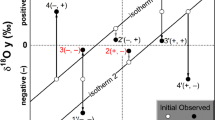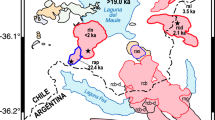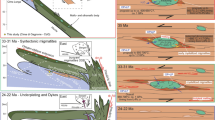Abstract
Kimberlites are volatile rich magmas that ascend from deep in the mantle at high velocities, then as they reach a ‘root zone’ at 1–3 km in depth they either discharge explosively through to the surface or stall to form dykes and sills. Understanding this eruptive behaviour is difficult due to a lack of data on volatile solubility, particularly at conditions where the magmas enter the ‘root zone’ (∼30–80 MPa). In this study, we perform experiments on some putative primary kimberlite magma compositions to assess the amount of CO2 and H2O retained if these compositions represent magma as it enters the root zone. At the conditions investigated (100–200 MPa and 1,275–1,100°C) the results suggest that none of these particular kimberlite compositions reproduce a magma that can retain the observed high volatile content when intruded at these pressures (∼4–8 km). In our experiments, the low volatile retention is due to a combination of factors including a high proportion of solid phases, none of which are volatile-bearing, and inadequate volatile solubilities in the subordinate amounts of melt present. Modelled solubilities also suggest that the dissolved volatile contents remain too low even at super-liquidus temperatures (i.e. 100% melt). For water, the higher values observed in natural rocks can be explained by the addition of H2O associated with ubiquitous post-emplacement serpentinization. The high CO2 contents in hypabyssal rocks are unlikely to be related to alteration. We suggest that most kimberlites originally had lower SiO2 contents and as such may have been ‘transitional’ between silicate and carbonate melts. This results in both higher CO2 solubilities and lower liquidus temperatures. For such compositions, it is possible that both CO2 and water solubility may first decrease and then increase as magmas decompress and crystallize. Such unusual behaviour can help explain why kimberlite magmas can be very explosive or form shallow hypabyssal intrusions.










Similar content being viewed by others
References
Appora I, Eiler JM, Matthews A, Stolper EM (2003) Experimental determination of oxygen isotope fractionations between CO2 vapor and soda-melilite melt. Geochim Cosmochim Acta 67:459–471
Bellis A, Canil D (2007) Ferric iron in CaTiO3 perovskite as an oxygen barometer for kimberlitic magmas I: experimental calibration. J Petrol 48:219–230
Berg GW, Carlson JA (1999) The Leslie kimberlite pipe of Lac de Gras, Northwest Territories, Canada. In: Gurney JJ, Richardson SR (eds) Proc 7th Int Kimberlite Conf. Red Roof Designs, Cape Town, pp 81–83
Blander B, Katz JL (1975) Bubble nucleation in liquids. AICHE J 21:833–848
Blank JG, Brooker RA (1994) Experimental studies of carbon dioxide in silicate melts: solubility, speciation and stable isotope behavior. MSA Rev Mineral 30:157–186
Blundy J, Cashman K (2008) Petrologic constraints on magma system variables and processes. MSA Rev Mineral Geochem 69:179–239
Brey GP, Ryabchikov ID (1994) Carbon dioxide in strongly silica undersaturated melts and origin of kimberlite magmas. Neus Jb Miner Mh H10:449–463
Brey GP, Kogarko LN, Ryabchikov ID (1991) Carbon dioxide in kimberlitic melts. Neus Jb Miner Mh 4:159–168
Brey GP, Bulatov VK, Girnis AV, Lahaye Y (2008) Experimental melting of carbonated peridotite at 6–10 GPa. J Petrol 49:797–821
Brooker RA (2006) The role of experiments and theory in understanding volatile control on the kimberlite eruption mechanism. Long abstract for 8th International Kimberlite Emplacement Workshop (IAVCEI), September, Saskatoon, Saskatchewan, 5 pp (available at www.8ikc.ca)
Brooker RA, Kjarsgarrd BA (2010) Silicate–carbonate liquid immiscibility and phase relations in the system SiO2–Na2O–Al2O3–CaO–CO2 at 0.1–2.5 GPa with applications to carbonatite genesis. J Petrol. doi:10.1093/petrology/egq081
Brooker RA, Kohn SC, Holloway JR, McMillan PF (2001) Structural controls on the solubility of CO2 in silicate melts. Part I: bulk solubility data. Chem Geol 174:225–240
Brown RJ, Kavanagh J, Sparks RSJ, Tait M, Field M (2007) Mechanically disrupted and chemically weakened zones in segmented dike systems cause vent localisation: evidence from kimberlite volcanic systems. Geology 35:815–818
Brown RJ, Gernon T, Stiefenhofer J, Field M (2008) Geological constraints on the eruption of the Jwaneng Centre kimberlite pipe, Botswana. J Volcanol Geotherm Res 174:195–208
Canil D, Bellis AJ (2007) Ferric iron in CaTiO3 perovskite as an oxygen barometer for kimberlite magmas II: applications. J Petrol 48:231–252
Canil D, Bellis AJ (2008) Phase equilibria in a volatile-free kimberlite at 0.1 MPa and the search for a primary kimberlite magma. Lithos 105:111–117
Canil D, Fedortchouk AJ (1999) Garnet dissolution and the emplacement of kimberlites. Earth Planet Sci Letts 167:227–237
Cookenboo H (1999) Emplacement history of the Jericho (JD-1) kimberlite pipe, Northern Canada. In: Gurney JJ, Richardson SR (eds) Proc 7th Int Kimberlite Conf. Red Roof Designs, Cape Town, pp 125–133
Dalton JA, Presnall DC (1998) The continuum of primary carbonatitic–kimberlitic melt compositions in equilibrium with lherzolite: data from the system CaO–MgO–Al2O3–SiO2–CO2 at 6 GPa. J Petrol 39:1953–1964
Dawson JB (1994) Quaternary kimberlite volcanism on the Tanzania Craton. Contrib Mineral Petrol 116:473–485
Dawson JB, Hawthorne JB (1973) Magmatic sedimentation and carbonatitic differentiation in kimberlite sills at Benfontain, South Africa. J Geol Soc Lond 129:61–85
Dixon JE (1997) Degassing of alkali basalts. Am Mineral 82:368–378
Edgar AD, Arima M, Baldwin DK, Bell DR, Shee SR, Skinner EMW, Walker EC (1988) High pressure–high temperature melting experiments on a SiO2-poor, CaO-rich aphanitic kimberlite from the Wesselton mine, Kimberley, South Africa. Am Mineral 73:524–533
Exley RA, Jones AP (1983) 87Sr/86Sr in kimberlitic carbonates by ion microprobe: hydrothermal alteration, crustal contamination and relation to carbonatite. Contrib Mineral Petrol 83:288–292
Fedortchouk Y, Canil D (2004) Intensive variables in kimberlite magmas, Lac de Gras, Canada and implications for diamond survival. J Petrol 45:1725–1745
Foley SF, Yaxley GM, Rosenthal A, Buhre S, Kiseeva ES, Rapp RP, Jacob DE (2009) The composition of near-solidus melts of peridotite in the presence of CO2 and H2O between 40 and 60 kbar. Lithos 112S:274–283
Haggerty SE (1989) Mantle metasomes and the kinship between carbonatites and kimberlites. In: Bell K (ed) Carbonatites: genesis and evolution. Unwin Hyman, London, pp 546–560
Hanson EK, Moore JM, Robey J, Bordy EM, Marsh JS (2006) Re-estimation of erosion levels in group I and II kimberlites between Lesotho, Kimberley and Victoria West, South Africa. Kimberlite Emplacement Workshop, Saskatoon, Canada. Long Abstract (available at www.8ikc.ca)
Harris M, Le Roex A, Class C (2004) Geochemistry of the Unitjiesberg kimberlite, South Africa: petrogenesis of an off-craton group 1 kimberlite. Lithos 74:149–165
Hawthorne JB (1975) Model of a kimberlite pipe. Phys Chem Earth 9:1–15
Holloway JR, Blank JG (1994) Application of experimental results to C–H–O species in natural melts. Min Soc Am Rev Mineral 30:187–230
Johnson ER, Wallace PJ, Cashman KV, Delgado-Granados H, Kent AJR (2008) Magmatic volatile contents and degassing-induced crystallization at Volcán Jorullo, Mexico: implications for melt evolution and the plumbing systems of monogenetic volcanoes. Earth Planet Sci Lett 269:478–487
Kamenetsky MB, Sobolev AV, Kamenetsky VS, Maas R, Danyushevsky LV, Thomas R, Pokhilenko NP, Sobolev NV (2004) Kimberlite melts rich in alkali chlorides and carbonate: a potent metasomatic agent in the mantle. Geology 32:845–848
Kavanagh J, Sparks RSJ (2009) Temperature changes in ascending kimberlite magmas. Earth Planet Sci Letts 286:404–413
Kavanagh J, Sparks RSJ (2010) Erratum to “Temperature changes in ascending kimberlite magma”. Earth Planet Sci Letts 289:629–630 [Earth Planet Sci Lett 286 (2009) 404–413]
Kelley SP, Wartho J-A (2000) Rapid kimberlite ascent and the significance of Ar–Ar ages in xenolith phlogopites. Science 289:609–611
Keppler H (2003) Water solubility in carbonatite melts. Am Mineral 88:1822–1824
Kilinc A, Carmichael ISE, Rivers ML, Sack RO (1983) The ferric–ferrous ratio of natural silicate liquids equilibrated in air. Contrib Mineral Petrol 83:136–141
Kjarsgaard BA, Harvey S, McClintock M, Zonneveld JP, Du Plessis P, McNeil D, Heaman L (2009a) Geology of the Orion South kimberlite, Fort à la Corne, Canada. Lithos 112S:600–617
Kjarsgaard BA, Pearson DG, Tappe S, Nowell GM, Dowall DP (2009b) Geochemistry of hypabyssal kimberlites from Lac de Gras, Canada: comparisons to a global database and applications to the parent magma problem. Lithos 112S:236–248
Klein-BenDavid O, Izraeli ES, Hauri E, Navon O (2007) Fluid inclusions in diamonds from the Diavik mine, Canada and the evolution of diamond-forming fluids. Geochim Cosmochim Acta 71:723–744
Kopylova MG, Matveev S, Raudsepp M (2007) Searching for parental kimberlite melt. Geochim Cosmochim Acta 71:3616–3629
Kurszlaukis S, Barnett WP (2003) Volcanological and structural aspects of the Venetia kimberlite cluster—a case study of South African kimberlite maar–diatreme volcanoes. S Afr J Geol 106:165–192
LeBas MJ (1981) Carbonatite magmas. Mineral Mag 44:133–140
Lensky NG, Niebo RW, Holloway JR, Lyakhovsky V, Navon O (2006) Bubble nucleation as a trigger for xenolith entrapment in mantle melts. Earth Planet Sci Lett 245:278–288
LeRoex AP, Bell DR, Davis P (2003) Petrogenesis of group I kimberlites from Kimberley, South Africa: evidence from bulk-rock geochemistry. J Petrol 44:2261–2286
Lorenz V, Kurszlaukis S (2007) Root zone processes in the phreatomagmatic emplacement model and consequences for the evolution of maar–diatreme volcanoes. J Volcanol Geotherm Res 159:4–32
Mattey DP, Taylor WR, Green DH, Pillinger CT (1990) Carbon isotopic fractionation between CO2 vapor, silicate and carbonate melts—an experimental study to 30 kbar. Contrib Mineral Pertrol 104:492–505
Mattsson B, Caricchi L (2009) Experimental constraints on the crystallization of natrocarbonatitic lava flows. Bull Volcanol 71:1179–1193
McMillan PF, Holloway JR (1987) Water solubility in aluminosilicate melts. Contrib Mineral Petrol 97:320–332
Métrich N, Bertagnini A, Landi P, Rosi M (2001) Crystallisation driven decompression and water loss at Stromboli volcano (Aeolian Islands, Italy). J Petrol 42:1471–1490
Mitchell RH (1986) Kimberlites: mineralogy, geochemistry and petrology. Plenum, NY, p 442
Mitchell RH (2005) Carbonatites and carbonatites and carbonatites. Can Mineral 43:2049–2068
Mitchell RH (2008) Petrology of hypabyssal kimberlites: relevance to primary magma compositions. J Volcanol Geotherm Res 174:1–8
Moore KR, Wood BJ (1998) The transition from carbonate to silicate melts in the CaO–MgO–SiO2–CO2 system. J Petrol 39:1943–1951
O’Neill HS (1987) Quartz–fayalite–iron and quartz–fayalite–magnetite equilibria and the free energy of formation of fayalite (Fe2SiO4) and magnetite (Fe3O4). Am Mineral 72:67–75
Ogilvie-Harris RC, Field M, Sparks RSJ, Walter MJ (2009) Perovskite from the Dutoitspan kimberlite, Kimberley, South Africa: implications for magmatic processes. Min Mag 73:915–928
Otto JW, Wyllie PJ (1993) Relationships between silicate melts and carbonate-precipitating melts in CaO–MgO–SiO2–CO2–H2O at 2 kbar. Mineral Petrol 48:343–365
Papale P, Moretti R, Barbato D (2006) The compositional dependence of the saturation surface of H2O + CO2 fluids in silicate melts. Chem Geol 229:78–95
Patterson M, Francis D, McCandless T (2009) Kimberlites: magmas or mixtures? Lithos 112S:191–200
Price SE, Russell JK, Kopylova MG (2000) Primative magma from the Jericho Pipe, N.W.T., Canada: constraints on primary kimberlite melt chemistry. J Petrol 41:789–808
Priestly K, McKenzie D, Debayle E (2006) The state of the upper mantle beneath Southern Africa. Phys Chem Earth In 416:101–112
Reid AH, Donaldson CH, Dawson JB, Brown WR, Ridley WI (1975) The Igwisi Hills extrusive kimberlite. Phys Chem Earth In 9:199–223
Scott BH (1979) Petrogenesis of kimberlites and associated potassic lamprophyres from Central West Greenland. In: Meyer OA (Ed) Kimberlites, diatremes and diamonds. Proceedings of the Second International Kimberlite Conference, vol 1, AGU, pp 190–205
Sparks RSJ, Baker L, Brown RJ, Field M, Schumacher J, Stripp G, Walters A (2006) Dynamical constraints on kimberlite volcanism. J Volcanol Geotherm Res 155:18–48
Sparks RSJ, Brooker RA, Field M, Kavanagh J, Schumacher JC, Walter MJ, White J (2009) The nature of erupting kimberlite melts. Lithos 112S:429–438
Spera FK (1984) Carbon dioxide in petrogenesis III: role of volatiles in the ascent of alkaline magma with special reference to xenolith-bearing mafic lavas. Contrib Mineral Petrol 88:217–232
Spera FK, Bergman SC (1980) Carbon dioxide in igneous petrogenesis I. Aspects of the dissolution of CO2 in silicate liquids. Contrib Mineral Petrol 74:55–66
Stripp GR, Field M, Schumacher JC, Sparks RSJ, Cressey G (2006) Post-emplacement serpentinization and related hydrothermal metamorphism in a kimberlite from Venetia, South Africa. J Metamorph Geol 24:515–534
Ulmer P, Luth RW (1991) The graphite–COH fluid equilibrium in P, T, ƒO2 space—an experimental determination to 30 kbar and 1600 degrees C. Contrib Mineral Petrol 106:265–272
Wilson MR, Kjarsgaard BA, Taylor B (2007) Stable isotope composition of magmatic and deuteric carbonate phases in hypabyssal kimberlite, Lac de Gras field, Northwest Territories, Canada. Chem Geol 242:435–454
Wyllie PJ (1989) Origin of carbonatites: evidence from phase equilibrium studies. In: Bell K (ed) Carbonatites: genesis and evolution. Unwin Hyman, London, pp 500–545
Xue X, Kanzaki M (2004) Dissolution mechanisms of water in depolymerized silicate melts: constraints from 1H and 29Si NMR spectroscopy and ab initio calculations. Geochim Cosmochim Acta 68:5027–5057
Zonneveld J-P, Kjarsgaard BA, Harvey SE, Heamand LM, McNeila DH, Marcia KY (2004) Sedimentologic and stratigraphic constraints on emplacement of the Star Kimberlite, east–central Saskatchewan. Lithos 76:115–138
Acknowledgments
The authors would like to acknowledge a NERC-CASE studentship awarded to JLK in association with DeBeers and support from a European Research Council Advanced Grant awarded to RSJS. We thank Richard Hinton and EIPG for help in developing the ion probe technique and De Beers MRM R & D Group for funding this project. We thank the support staff at University College London where the experiments were performed. We are very grateful for the helpful reviews from Dante Canil, Robert Luth and Maya Kopylova.
Author information
Authors and Affiliations
Corresponding author
Additional information
Editorial responsibility: J.K. Russell
This paper constitutes part of a special issue: Cas RAF, Russell JK, Sparks RSJ (eds) Advances in Kimberlite Volcanology and Geology.
Rights and permissions
About this article
Cite this article
Brooker, R.A., Sparks, R.S.J., Kavanagh, J.L. et al. The volatile content of hypabyssal kimberlite magmas: some constraints from experiments on natural rock compositions. Bull Volcanol 73, 959–981 (2011). https://doi.org/10.1007/s00445-011-0523-7
Received:
Accepted:
Published:
Issue Date:
DOI: https://doi.org/10.1007/s00445-011-0523-7




